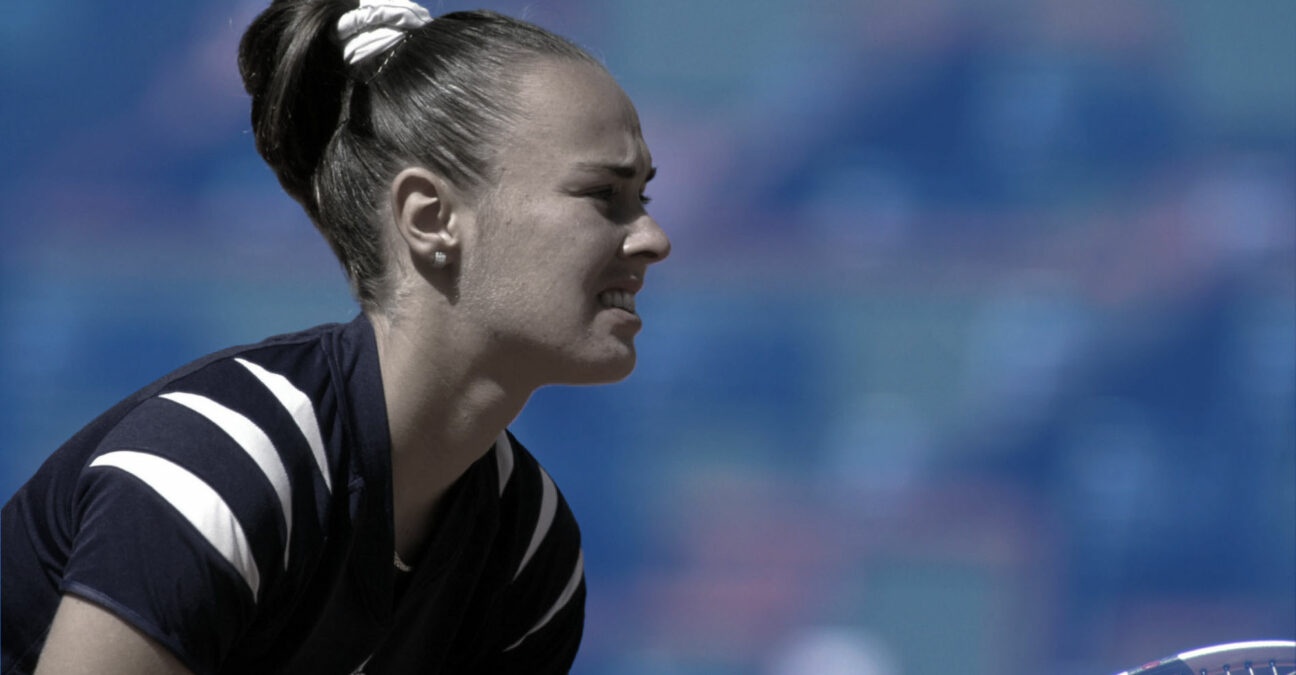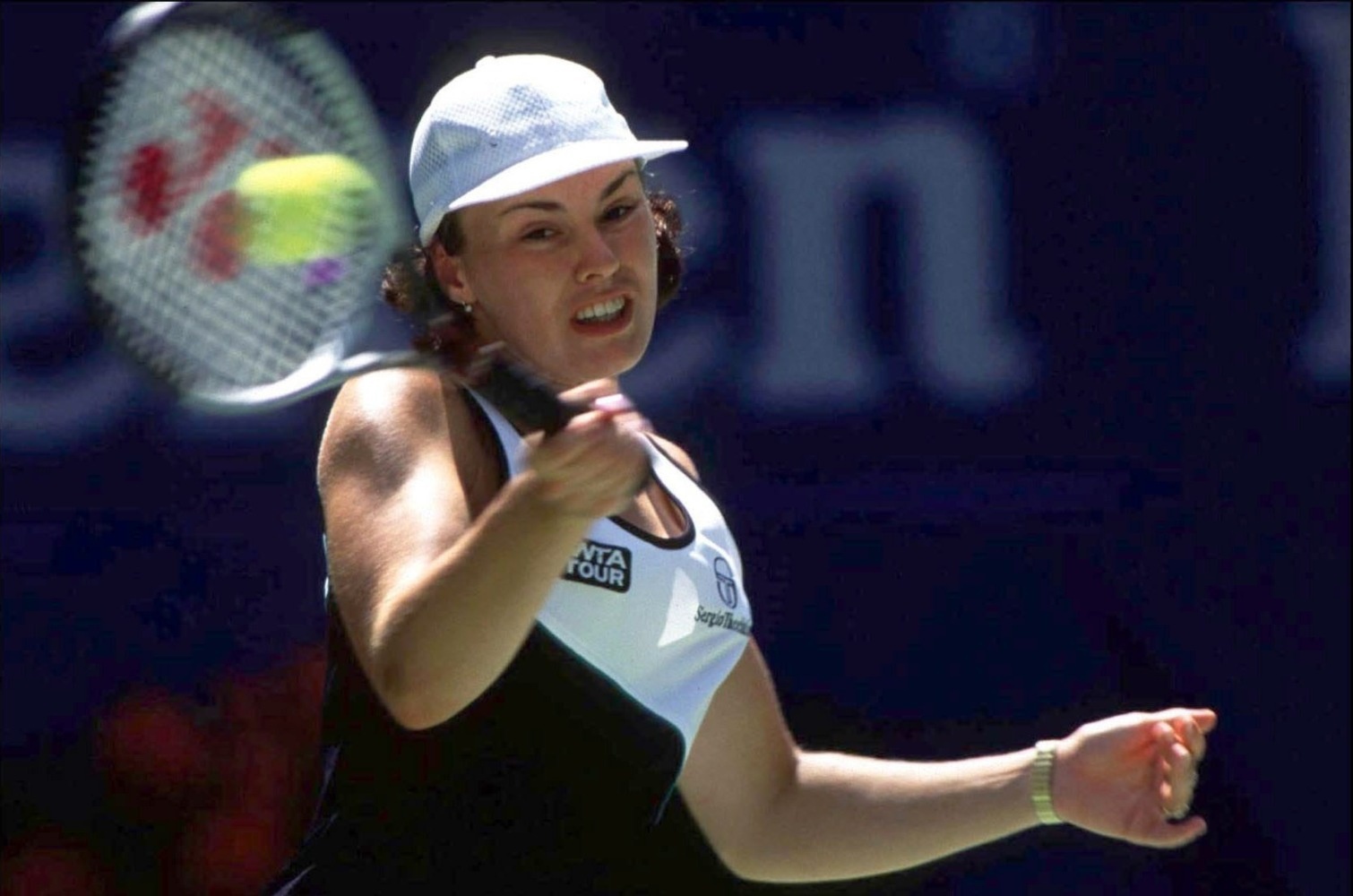March 30, 2000: The day Martina Hingis double-bagelled Monica Seles, but lost the world No 1 spot
Every day Tennis Majors takes you back in time to celebrate a great moment in tennis history. Today, we go back to 2000 to witness how, in the semi-finals of the Miami Open, Martina Hingis was the first and last player to ever defeat Monica Seles without losing a single game.
 Martina Hingis, Roland-Garros 2000 – © Alain Mounic / Panoramic
Martina Hingis, Roland-Garros 2000 – © Alain Mounic / Panoramic
What exactly happened on that day?
On this day, March 30, 2000, in the semi-finals of the Miami Open, Martina Hingis, the world No 1, destroyed former No 1 and nine-time Grand Slam champion, Monica Seles, 6-0, 6-0. Never in her career had Seles – who was suffering from an ankle sprain – left the court without being able to score a single game. However, this win didn’t prevent Hingis from losing the top spot to Lindsay Davenport at the end of the tournament.
The players involved: Martina Hingis and Monica Seles
- Martina Hingis, the prodigy
Martina Hingis was born in September 1980, and her mother Melanie Molitor named her after tennis champion Martina Navratilova. Taught by her mum, she soon became a real prodigy, winning the junior event at Roland-Garros at the age of 12. She started competing on the tour at 14, but she was allowed to attend only 15 tournaments before the age of 16, a rule she protested against. Her game relied on an extraordinary hand-eye coordination, great tactics, amazing touch, and great anticipation. In her early career, she was still said to lack power and a decent second serve.
As the youngest player to ever win match at the Australian Open in 1995, she broke through in 1996. After defeating the undisputed world No 1, Steffi Graf, at the Italian Open in May, she reached the semi-final at the US Open, where Graf beat her 7-5, 6-3, and she finished runner-up at the US Open (defeated by Graf, this time in five sets, 6-3, 4-6, 6-0, 4-6, 6-0).
Three months after a 16th birthday, she was already the 6th player in the world, and in January 1997, she became the youngest Grand Slam champion in the Open Era, defeating Mary Pierce in the final (6-2, 6-2). Two months later, she also became the youngest world No 1 in WTA history, and throughout the season, she claimed no less than 12 titles, including Wimbledon (beating Jana Novotna in the final, 2-6, 6-3, 6-3) and the US Open (defeating Venus Williams in the final, 6-0, 6-4).
At the 1998 Australian Open, she was the youngest player in the Open era to ever defend a Grand Slam title. Although, at the time, it seemed that Hingis’s heavy domination was made to last, she would soon struggle to contain the power of the rising generation of players, including the Williams sisters. She won the Australian Open for a third time in 1999, but she then lost a heartbreaking final to Steffi Graf at Roland-Garros (4-6, 7-5, 6-2). After she was defeated in two back-to-back Grand Slam finals at the US Open (lost to Serena Williams, 6-3, 7-6) and at the 2000 Australian Open (lost to Lindsay Davenport, 6-1, 7-5), many experts started to think that she was definitely losing her grip on the women’s game.

- Monica Seles, “only’ world No 9
Monica Seles had been one of the most successful players in the world at a particularly young age. Her powerful two-handed groundstrokes, her innovative way of hitting the ball so early with so much power, and of course her trademark grunting, represented an absolute revolution in the women’s game. In 1989, she played her first full year on the tour and, after claiming her first title at spring in Houston, she played her first Grand Slam main draw in Roland-Garros.
This first appearance in Paris would be long remembered. In the third round, facing world No 4 Zina Garrison, young Monica, aged 15, gave away flowers to the Center Court public before crushing her opponent 6-3, 6-2. She went on to the semi-final where she was only defeated in three sets (6-3, 3-6, 6-3) by the unbeatable Steffi Graf, who had won the last five Grand Slam tournaments. In 1990, at the age of 16, she was the youngest ever player to win Roland-Garros. It was the start of her domination on the tour. In March 1991, aged 17, she became the youngest world number one in tennis history, knocking over Steffi Graf from the throne she had been sitting on since the summer of 1987.
From January 1991, Monica Seles won seven out of the eight Grand Slam tournaments she participated in, losing only the 1992 Wimbledon final, setting a 56-1 victory-loss record. Furthermore, she claimed three Masters Cups in a row in 1990, 1991 and 1992. Her career was brutally interrupted on April, 30, 1993, in the quarter-finals of the Hamburg Open, when she was stabbed at a changeover by a mentally unstable Steffi Graf fan. The psychological wound proved to be much deeper than the knife-blow itself. Although she was physically ready to play just a few months afterwards, it would take over two years before she played on the tour again, while she became a US citizen in 1994.
She came back under the spotlight in the summer of 1995, winning her first tournament, in Toronto (defeating Amanda Coetzer, 6-1, 6-0). A few weeks later, she finished runner-up at the US Open (lost to Steffi Graf, 7-6, 0-6, 6-3). At the start of 1996, aged 22, she won her last Grand Slam tournament at the Australian Open. In the final, she defeated Anke Huber, from Germany (6-4, 6-1). Since then, she remained a top ten player, but, suffering with food disorders and weight issues that she would later describe in her book, she never lifted a Grand Slam trophy again.
She still reached the final round twice, at the US Open 1996 (defeated by Graf, 7-5, 6-4) and at Roland-Garros 1998 (defeated by Sanchez, 7-6, 0-6, 6-2). However, since then, her results were not on the same standards, and in March 2000, she was “only” world No 9.

The place: Miami
The Miami Tennis Open, originally named the Lipton International Players Championship, was held for the first time in 1985, in Delray Beach, with the idea of being the first big tennis event of the year (at the time, the Australian Open was held in December). The tournament moved to Key Biscayne in 1987. The event was played on slow hard courts, in extreme heat and humidity. Nonetheless, with outstanding prize money and a 96-player draw. In 2000, it was still considered as one of the biggest tennis tournaments in the world outside of Grand Slams, with an impressive list of former champions such as, amongst others, Martina Navratilova, Steffi Graf, Monica Seles and Venus Williams.
The facts: 39 minutes, 6-0, 6-0!
At the 2000 Miami Open, the semi-final clash between the world No 1, Martina Hingis, and a former No 1, Monica Seles, still ranked No 9 in the world, had all the ingredients for a great match. The stands of the Key Biscayne main arena were packed with 14,000 spectators who expected a great show.
However, what the audience couldn’t know was that Seles had unfortunately sprained her ankle during her quarterfinal win against Amy Frazier (6-0, 6-3). Despite the injury, she decided to try her chance in the semi-finals against Hingis, the world No 1, who had defeated her in their four last meetings, the last one just a few weeks ago, at Indian Wells (6-3, 6-1).
If Seles had hoped that a good warm-up would ease the pain and allow her to move, then she was disappointed. She could barely move and was forced to take enormous risks on each shot to win some points. If Seles had expected any mercy from her young opponent, then she was wrong. The world No 1 swept her off the court in only 39 minutes without losing a single game. It was the first time in her entire career that Seles was given a double-bagel; so far, her worst beating had been a 6-0, 6-1 loss to Steffi Graf at Wimbledon, in 1989 – she was 15 years old.
Hingis had obviously noticed that her opponent was injured.
“Not everyone knows what’s going on behind the scenes,” the Swiss told the press. “Monica just wasn’t herself today.”
Hingis herself, despite qualifying for the final so easily, had reasons to be disappointed: in the other half of the draw, Lindsay Davenport, world No 2 at the time, edged Sandrine Testud (6-1, 6-7, 7-6), which would make her the new No 1 on the following Monday – no matter who would win the Key Biscayne final.
Years later, in her autobiography, Getting a Grip: On My Body, My Mind, My Self, the youngest Roland-Garros champion in tennis history would recall the 2000 Miami semi-finals.
“It was the worst defeat of my career and the quickest: a measly thirty-nine minutes. I was mortified. The fighter in me had refused to default even though it would have been the smarter choice. As the crowd threw raucous catcalls, boos and whistles at me, I could feel my face flushing with embarrassment and I hobbled off the court as quickly as my ankle would let me. For the first time in my career I had failed to win even one game. Not one.”
What next? Hingis would never win a Grand Slam again
On the following day, although she was about to lose the world No 1 spot to Davenport, Hingis was the one who would lift the Miami trophy, easily defeating her rival, 6-3, 6-2. However, she would never win a Grand Slam tournament again. She would appear at the top of the WTA rankings for the last time on October 14, 2001, having occupied the spot for a total of 209 weeks.
After a heartbreaking loss to Jennifer Capriati in the final of the 2002 Australian Open, bothered by a foot injury, she would announce her retirement in February 2003. She would be back on the Tour in 2006, but she would never go past the quarter-finals of a Grand Slam tournament until she was tested positive for cocaine at Wimbledon and suspended at the end of the year. She would then come back a last time in the 2010s, in doubles, claiming four additional Grand Slam titles. She would retire once and for all in 2017.
Monica Seles would obtain her last remarkable results, at the 2000 Sydney Olympics, where she would obtain the bronze medal, and at the 2002 Australian Open, where she would reach the semi-finals (defeated by Hingis, 4-6, 6-1, 6-4). Struggling with a foot injury, she would play her last match ever at Roland-Garros in 2003, which she would lose against Nadia Petrova (6-4 6-0), although she would only announce her official retirement in 2008.









